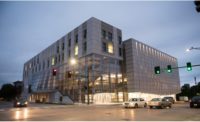Most people in the built environment community are aware that using and specifying sustainable and resilient materials and designs is “the right thing to do.” There has been and continues to be industry discussions about the environment and climate change; sustainability and resilience are sometimes just assumed to address environmental and climate change concerns in ways that are “good.” But sometimes, these words are used without really appreciating whether or not they are essentially the same, different, or in some way linked.
The built environment represents a large consumer of resources, both in terms of materials and energy. The U.S. Energy Information Agency estimates that residential and commercial/industrial buildings consume 40 percent of the energy used in the U.S. Of that, the majority is used for heating, air conditioning, ventilation and lighting. Non-energy resource use, including material use, construction waste, operating resources such as water, and end of life demolition waste is far harder to estimate, but is significant. However, the construction market is estimated to be $1.231 trillion for 2018, versus a total gross domestic product of $20.412 trillion. This means the construction market represents around 6 percent of the U.S. economy.
Due to the impact of the built environment on both energy use and resource consumption, it’s important to reach a better understanding of sustainability and resilience. Are these terms the same, complimentary, or independent? This article will examine each in turn and then compare the two. As will be seen, they are not the same and, sometimes, can conflict in ways that are counter to goals generally regarded as “good.”
Sustainable
This adjective generally means:
- Able to be used without being completely used or destroyed.
- Involving methods that do not completely use up or destroy natural resources.
- Able to last or continue for a long time.
Sustainability (the noun) is the capacity for:
- Human health and well being
- Economic vitality and prosperity
- Environmental resource abundance
So, the building designer who wishes to incorporate sustainability into buildings might ask:
- Are materials safe for humans and the ecosystem?
- Is this design energy and resource efficient?
- Is a material available or will its use today cause a shortage in the future?
Resilience
This noun generally means:
- An ability to recover from or adjust easily to misfortune or change.
- The ability to become strong, healthy or successful again after something bad happens.
Putting this in terms of the built environment, resilience is the capacity to:
- Overcome unexpected problems.
- Continue or rapidly bounce back from extreme events.
- Prepare for and survive catastrophes.
So, key questions for the building designer are:
- Can a structure be occupied and functional after a severe storm or some other extreme environmental event?
- Will occupants be able to function in the absence of utilities?
- What reduction in occupational capacity is acceptable after an extreme environmental event?
Sustainable versus Resilient
To compare the two terms, it’s instructive to examine some design choices. The schematic below shows some examples of choices that represent more or less of the two characteristics:
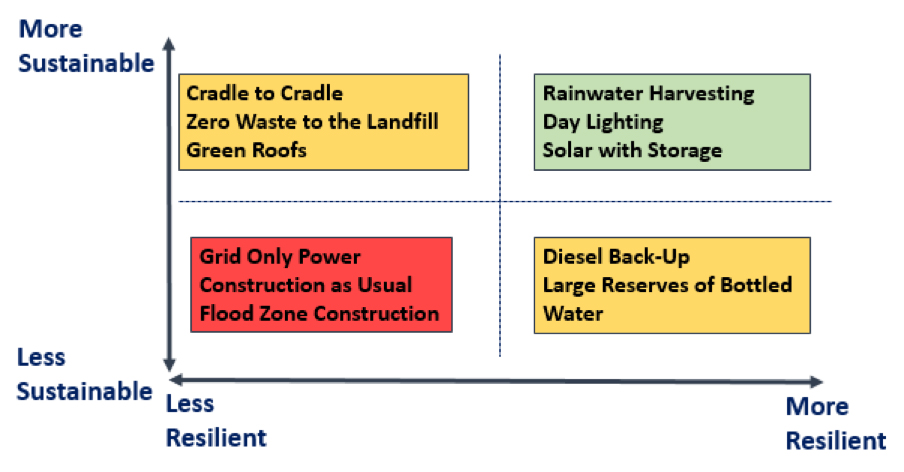
The following is a discussion of some of the examples shown in each of the quadrants:
Less Sustainable/Less Resilient
In the lower left corner, “Grid Only Power” refers to a building’s reliance on grid electricity supply. The national grid gets about 17 percent of its power from renewable sources such as wind and solar. The remainder is from fossil fuels and nuclear and therefore today’s grid power, while improving, can be regarded as less sustainable versus, for example, a grid that was essentially all supplied from renewable resources. From a building use perspective, grid-only power is likely the least resilient choice of energy since a building’s power could be cut not just by an event locally but anywhere within the region. Properly designed and installed solar energy with storage, as indicated in the upper right quadrant of the Figure, would be more resilient.
More Sustainable/Less Resilient
In the upper left corner, “Zero Waste to the Landfill” typically refers to the production of a material that does not result in any waste being landfilled. Instead, any manufacturing scrap is recycled either back into the product or into other materials. The term can also refer to construction practices that recycle all waste. Eliminating waste by recycling is generally regarded as a sustainable endeavor but in no way does it impact a building’s resilience in the face of future extreme events.
Less Sustainable/More Resilient
In the lower right corner, “Large Reserves of Bottled Water” refers to a planning approach aimed at withstanding a loss of water due to some extreme weather event. Such water reserves could indeed be invaluable during such an outage, but plastic bottles are generally not viewed as being a sustainable choice. It’s worth noting that while the loss of water might be viewed as a very unlikely possibility, it occurred in high buildings throughout New York City in the aftermath of Superstorm Sandy in 2012. In tall buildings, the water supply to higher floors and sometimes the entire building is totally reliant on electric pumps. Therefore, loss of grid power quickly leads to a loss of water supply.
More Sustainable/More Resilient
In the upper right hand corner, “Solar with Storage” refers to the use of solar panels coupled with battery power storage to withstand temporary loss of grid power. Solar power is widely regarded as being more sustainable than fossil-fueled power plants, for example. However, solar power systems typically shut down during a grid outage to prevent the system from attempting to power the neighborhood. The addition of battery storage enables a system that would shut off from the grid and provide uninterrupted power for some time after the loss of grid power. The degree of resilience would depend on many factors including the size of the solar array, amount of battery storage, the power usage within the building etc.
Sustainable versus Resilient—Conclusion
It should be clear from the discussion so far, that sustainable and resilient are two different considerations and are independent of each other. Simply because a material or design is sustainable doesn’t mean that it is resilient and vice versa.
The following section examines sustainable and resilient choices for low-slope roofing.
Sustainable Roofing
Discussions about sustainable roofing are mostly about the materials used. Some materials used in the past, such as asbestos insulation, would be regarded as unsustainable given their potential for harm. But, given today’s wide array of choices, how is a building professional able to make decisions as to whether a particular material is sustainable or not? There are many opinions and options, but LEED v.4 provides a common baseline that can be useful in making decisions. LEED contains a Building Product Disclosure & Optimization (BPD&O) section that encourages:
- Use of products having an Environmental Product Declaration (EPD), this being an internationally accepted, verified and published report focusing on the ways in which a product affects the environment throughout its life cycle.
- A publicly available report from raw material suppliers which include raw material supplier extraction locations, a commitment to long-term ecologically responsible land use, a commitment to reducing environmental harms from extraction and/or manufacturing processes, and a commitment to meeting applicable standards or programs voluntarily that address responsible sourcing criteria.
- Disclosure of the material ingredients through documentation such as Health Product Declarations (HPD).
In addition, as part of the LEED Building Design & Construction—Sustainable Site section, there are credits given for Heat Island Reduction through the use of cool roofing or reflective membranes.
Membranes
The following table summarizes the status of the major types of low slope roofing membranes in terms of BPD&O and cool roof status:
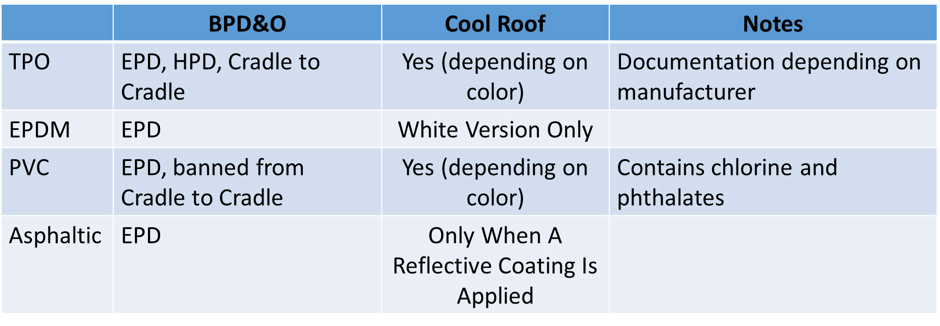
BPD&O - Building Product Disclosure & Optimization
EPDM, while a popular membrane, is generally not used as a white version due to its added cost. Also, when the market share of the various membrane types is considered, as in the following chart, it’s apparent that TPO should be examined closely for its sustainable characteristics.
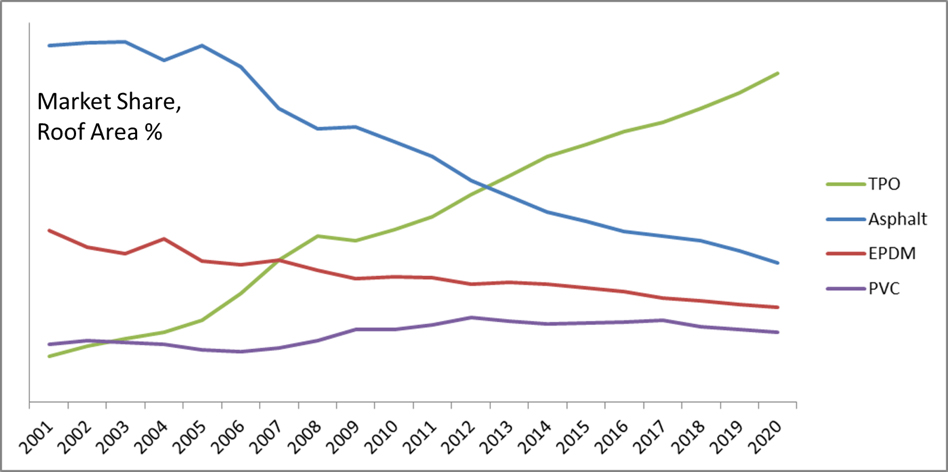
The chart shows a projection over the coming years and it is clear that TPO has become the dominant low slope membrane. Also, as older TPO roofs come up for replacement, it’s possible that the long term trend towards TPO will accelerate. Examining TPO in terms of sustainability shows:
- TPO typically doesn’t contain any “red list” materials.
- TPO can be obtained with up to 35 year warranties, depending on type, installation, thickness and manufacturer. Materials with long life cycles are widely regarded as being more sustainable.
- TPO can potentially be recycled at the end of its useful life as a roof membrane.
Insulation
Since insulation is used to reduce long-term energy demand for heating and air conditioning, its use is generally considered sustainable. The status of the major insulation materials used in low slope roofing in terms of BPD&O is shown in the following table:

BPD&O – Building Product Disclosure & Optimization. Certification and documentation depends on individual manufacturer.
As for membranes, it is instructive to examine the market share of each of these materials, as shown below:
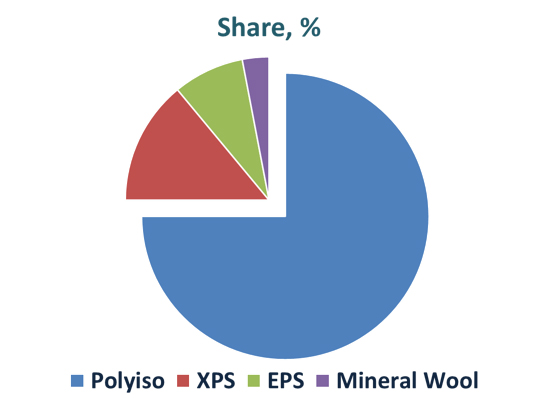
In examining polyiso more closely, it’s apparent that it is generally a good choice especially when the non-halogen version is specified. The material has a low water vapor permeance, is thermoset (i.e. doesn’t melt during fires), and isn’t negatively affected by solvents.
Balance of System
Any roof assembly consists of more than the membrane and insulation. The additional components necessary to complete any roofing system, depending on exact design, are discussed as follows:
Cover Boards—the use of gypsum boards can provide LEED Materials and Resources credit. Similarly, high density polyiso boards, when specified in the non-halogen version can provide LEED BPD&O credit.
Adhesives—traditional solvent based adhesives are still used in many regions, but tightening environmental regulations have led to increased use of water-based and low VOC (volatile organic content) materials. There are few available with an EPD or HPD, however water-based and low VOC materials are regarded as being more sustainable versus solvent based materials.
Fasteners—in terms of overall content, fasteners are a very small proportion of a roofing assembly and many might consider them to have an insignificant contribution to sustainability. However, in the case of coated plates that allow inductive heating attachment of the membrane, this enables most of the benefits of fully adhered systems to be achieved without the use of adhesives.
Resilient Roofing
Sustainable roofing is mainly focused on material choices:
- Content / how they are manufactured
- Life cycle
- Length of use / Durability
However, resilient roofing is concerned with how those materials are used together in a roof design to better protect against large and severe deviations from normal weather patterns. Such events can be:
- High Wind / Storms—wind and storms of above normal expectations require roof assemblies with enhanced wind uplift resistance. This requires care with design details as well as a good understanding of wind load fundamentals and design basics. As high wind events and storms increase in severity, it is worth considering the use of known designs that improve wind uplift resistance. An example would be specifying fully adhered membranes versus mechanical attachment.
- —data from the U.S. Department of Commerce shows hail damage to property as being economically very significant:
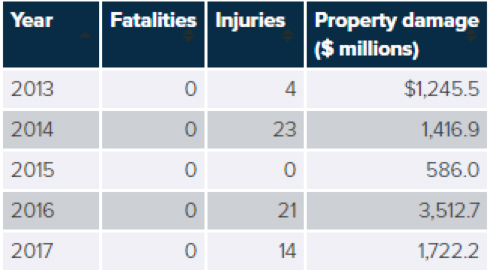
While long-term trends are debatable, there is a sense that a combination of changing climate combined with increased population densities in areas at risk are leading to a long-term trend towards more claims. Studies have shown that more conservative single ply roof assemblies, consisting of fully adhered fleeceback membrane over high-density polyiso cover boards that are also adhered can lower the risk of ice ball impacts. Furthermore, TPO designed for longer term weather resistance may provide longer term protection against impact.
- Loss of Heat—grid power brownouts and outages due to weather related incidents have been trending upwards, according to the U.S. Energy Information Agency.
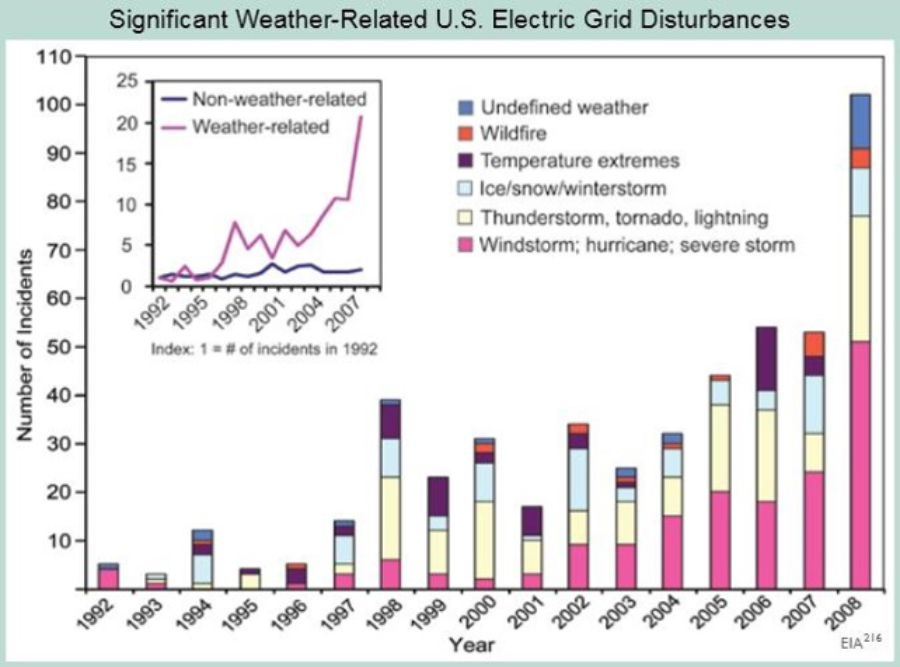
Electrical power outages, in turn, lead to a loss of building heat or air conditioning which can reduce or prevent functional business operations in affected buildings. From a low slope roof design perspective, insulation and air barrier requirements can help reduce energy loss during power outages and thereby make a building more resilient. Insulation can be specified to go beyond code requirements but even seemingly minor changes in installation can improve its efficiency. For example, always making sure that insulation is installed in two layers with staggered joints helps reduce thermal loss through gaps. Also, specifying fully adhered membranes and adhering the top layer of insulation can reduce thermal bridging.
Sustainable versus Resilient Roofing—in Conclusion
Sustainable roofing is mostly about material choices. Of today’s common materials, TPO roofing membranes and non-halogen polyiso insulation are generally accepted as meeting sustainability requirements. For the balance of system materials, non-halogen high-density polyiso and gypsum cover boards also are considered sustainable materials. For securement, low VOC and water-based adhesives are available as replacements for traditional solvent based systems.
Resilient roofing enhances the ability of buildings to continue to function after extreme weather events. It is mainly the roof assembly design that determines resiliency of the roof together with workmanship and quality of installation. As discussed in this article, there are many known designs available to improve on resiliency beyond a basic system that simply meets code requirements. Such systems can include fully adhered systems to increase wind uplift resistance, the use of fully adhered fleeceback membranes and adhered high-density polyiso cover boards to improve protection against impact, and increased insulation to help reduce heat gain/loss during power outages.
As a final note, it may be worth considering that many would argue that climate change might induce more extreme weather challenges than are planned for today. It might be important to consider adaptation strategies to improve resilience of the built environment towards future climate changes.
For more articles from Tom Taylor, visit blog.gaf.com.


